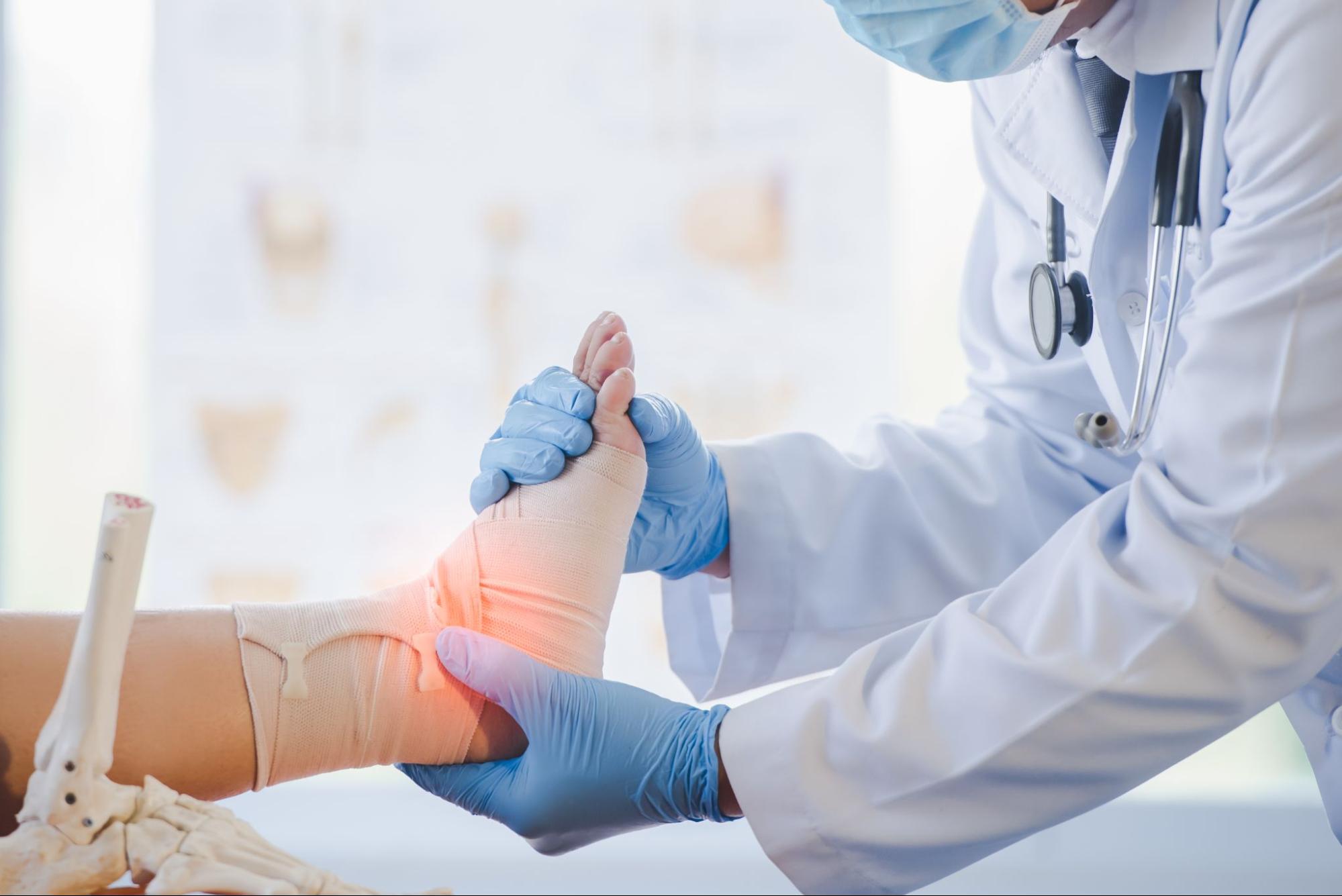Osteoarthritis of the Ankle and Foot

Osteoarthritis of the ankle and foot affects the joints of the ankle and foot.
Osteoarthritis refers to the inflammation of joints due to breakdown or damage to the cartilage surrounding the joints. Ankle and foot osteoarthritis affects the joints in the ankles and feet, which can lead to joint pain and stiffness.
Ankle and foot osteoarthritis are not as common as hip or knee osteoarthritis, it is also more common in older people and female patients [3].
Understanding the ankle and foot joints
The foot and ankle consists a total of 33 joints, the main joints include [1, 2]:
- Talocrural (ankle) joint – The joint between the tibia (leg bone) and the talus.
- Subtalar joint – The joint involving the talus, calcaneus, and navicular bones of the hindfoot.
- Transverse tarsal (midtarsal) joints – Transverse tarsal joints are made up to two joints which are the talonavicular joint (talus and navicular bones) and calcaneocuboid joint (calcaneus and cuboid bones).
- Midfoot joints – Midfoot joints include tarsometatarsal joints, midtarsal joints, naviculo-cuneiform joints.
- Metatarsophalangeal joints – Metatarsophalangeal joints are the joints between the metatarsals and proximal phalanges (toe bones).
- Interphalangeal joints – Interphalangeal joints are the joints between the proximal and distal phalanges (toe bones).

There are 33 joints in the foot and ankle, all of which can be affected by osteoarthritis of the ankle and foot.
Any of these joints can be affected by osteoarthritis of the ankle and foot. The most commonly affected joints are the first metatarsophalangeal joint, second cuneiform-metatarsal joint, talonavicular joint, naviculo-cuneiform joint, and first cuneiform-metatarsal joint [2].
What are symptoms of ankle and foot osteoarthritis?
Symptoms of ankle and foot osteoarthritis are similar to symptoms of osteoarthritis of other joints. Common signs and symptoms of osteoarthritis of the ankle and foot include:
- Joint pain of the ankle or foot
- Joint stiffness of the ankle and foot
- Swelling of the joints
- Reduced range of motion of the ankle and foot joints
- Exostosis (bony spurs and growths) of the foot
- Creaky or clicking joints
- Difficulty walking
Due to ankle and foot osteoarthritis being less common, the condition might be mistaken for other ankle and foot conditions. Hence, it is important to get a proper diagnosis with an orthopaedic specialist to receive the correct treatment.
Stages of osteoarthritis of the ankle and foot
Grading or staging of ankle and foot osteoarthritis has not been fully explored, one of the most well-known methods to describe the stages of ankle osteoarthritis is the Tanaka classification as below [4]:
|
Stage |
Cartilage loss |
Description |
|
1 |
Minor wear and tear |
No joint space narrowing, sclerosis (hardening of tissues) and osteophyte (bone spurs) formation present |
|
2 |
Minor cartilage loss |
Narrowing of the medial joint space present |
|
3A |
Partial cartilage loss |
Absence of joint space with the subchondral bones (bones with hyaline cartilage) touching each other |
|
3B |
Extension of joint space obliteration to the roof of the dome of the talus bone |
|
|
4 |
Complete loss of cartilage |
Obliteration of the entire joint space, the bones are completely in contact with each other |
What causes osteoarthritis of the ankle and foot
Unlike osteoarthritis of the other joints, primary osteoarthritis is not commonly the cause of ankle and foot osteoarthritis. The common causes of osteoarthritis of the ankle and foot are:
- Traumatic injuries – Post-traumatic osteoarthritis represents the most common cause of osteoarthritis of the ankles and feet (75 – 80%) [2 – 4]. Examples of traumatic injuries that were reported to contribute to ankle and foot osteoarthritis include ankle fractures and ligament instability [4].
- Underlying joint conditions – Underlying conditions such as rheumatoid arthritis, haemochromatosis, haemophilia, and osteonecrosis, represent around 13% of ankle and foot osteoarthritis causes [4].
- Primary osteoarthritis – Primary or idiopathic (unknown causes) osteoarthritis represent 7 – 9% of ankle and foot osteoarthritis causes [4].
Risk factors of osteoarthritis of the ankle and foot
Cross-sectional studies on ankle and foot osteoarthritis incidences found several risk factors that may contribute to the development of osteoarthritis in the ankles and feet, these include [3]:
- Old age – Older people (>65 years old) are more likely to be affected with ankle and foot osteoarthritis. This may be due to the increased risk of osteoarthritis caused by wear and tear of the joints.
- Female sex – In general, women are more likely to be at risk of osteoarthritis. This can be caused by several factors such as anatomical differences, muscle strength, and hormonal influences [5].
- Obesity – Obesity and excess body weight can contribute to osteoarthritis of the ankle and foot due to increased wear and tear, or workload of the joints.
- Routine or manual labour – Routine and manual occupations are associated with foot and midfoot osteoarthritis. This can also be due to increased wear and tear of the ankle and foot joints.
Diagnosis of osteoarthritis of the ankle and foot
Diagnosis of osteoarthritis of the ankle and foot are usually done by imaging methods. Proper diagnosis of the condition can be challenging, considering the uncommon nature of the disease as well as the proximity of the foot bones [2]. Doctors usually perform the following tests to diagnose ankle and feet osteoarthritis:
- Clinical assessment – Clinical assessment of the ankle and foot is done in the doctor’s office. The doctor will typically ask questions about your symptoms and medical history (previous procedures or injuries). The doctor may also ask you to walk or do certain movements to evaluate range of motion and gait. Palpations of the foot can also be done to check for swelling in the ankle or foot.
- X-ray radiograph – X-ray radiographs are usually done to look for the narrowing of the joint space or contact between the bones. X-ray radiographs cannot tell the doctor how much cartilage in your ankle or foot is damaged or lost.
- Magnetic resonance imaging (MRI) scan – MRI scans are used to observe cartilage damage in the ankle and foot.
- Computed tomography (CT) scan – Similar to MRI scans, CT scans are used to identify cartilage damage and loss between the ankle and foot bones.

Timely and appropriate treatment for ankle and foot osteoarthritis can help manage pain, preserve mobility, and slow disease progression.
Treatment of osteoarthritis of the ankle and foot
Treatment of ankle and foot osteoarthritis can be approached similarly to osteoarthritis of other joints. Common treatments for osteoarthritis of the ankle and foot include [2, 4]:
Pharmacological treatment
- Topical acetaminophen, nonsteroidal anti inflammatory drugs (NSAIDs) and capsaicin – Topical application of acetaminophen, NSAIDs, or capsaicin is done for minor cases of ankle and foot osteoarthritis. The main goal is to relieve pain and discomfort.
- Oral NSAIDs – Oral NSAIDs are usually prescribed when topical analgesia is not effective in relieving pain and inflammation of the joints. Common oral NSAIDs prescribed include cyclooxygenase 2 (COX2) inhibitors such as etodolac, naproxen, and piroxicam. Use of oral NSAIDs should only be done under a doctor’s prescription.
- Slow-acting drugs – Certain drugs, typically supplements, can be taken to relieve joint pain and inflammation by improving synovial and hyaluronic acid production, which in turn improves lubrication and shock absorbance of the joints. Common drugs that can be taken include glucosamine, chondroitin sulfate, and diacerein.
Intra-articular injections
- Hyaluronic acid – Hyaluronic acid injections into the joint spaces are known to relieve pain and stiffness, as well as improve joint functionality. The injections can last between 6 to 18 months.
- Corticosteroids – Corticosteroid injections are typically used for short-term pain relief for a period of 4 to 8 weeks. Corticosteroid injections are usually reserved for severe or persistent pain in advanced stages of osteoarthritis, and are not meant to be a routine treatment.
- Platelet-rich plasma (PRP) – PRP injections for ankle and foot osteoarthritis are known to relieve pain and improve joint function, similar to hyaluronic acid injections. The effects of PRP injections can last up to 16 months, PRP injections are also used in cases to delay the need for surgical intervention.
Surgical treatments
- Arthroscopic joint debridement – Arthroscopic joint debridement is a minimally invasive surgical treatment mainly indicated to slow down osteoarthritis progression. The procedure involves making 2 small incisions on the ankle or foot, inserting an arthroscope from one incision, while performing the debridement from the second incision. Debridement is done to remove bone spurs and clean up the surrounding area of the joint.
- Arthrodiastasis – Arthrodiastasis is also known as joint distraction, where the joints are mechanically unloaded and realigned. The procedure is typically done on ankle osteoarthritis using a brace, or external fixator and pins to ‘stretch out’ the joints. The procedure is thought to optimise the self-healing properties of the ankle cartilage by mechanical unloading and restoring hydrostatic fluid pressure changes in the joint [6]. The procedure is also mainly indicated for younger patients (< 45 years old).
- Osteotomy – Osteotomy procedures involve cutting or reshaping of the bone structures to realign the bones or joints. Osteotomy is typically used in cases of malaligned joints. Osteotomy procedures were reported to reduce pain in 70 to 75% of cases, and defers the need for more serious surgical interventions such as arthrodesis and arthroplasty.
- Arthroplasty – Arthroplasty is a joint reconstruction or replacement procedure using a prosthetic. Total ankle arthroplasty is commonly indicated for patients with primary or post-traumatic osteoarthritis with moderate to severe pain, loss of mobility, and function of the joint. Usually, patients who experience these symptoms are at the end-stages of osteoarthritis with limited mobility.
- Arthrodesis – Ankle arthrodesis is also another treatment reserved for end-stage osteoarthritis. Arthrodesis is also known as joint fusion, the procedure involves removing the joints to allow the bones to fuse together, this can affect the patient’s gait. The main goal of arthrodesis is to achieve a stable, pain-free ankle that is able to bear weight. The surgery can be performed as an open arthrodesis or an arthroscopic arthrodesis.
Treatment options for ankle and foot osteoarthritis depend on the disease stage, severity of pain, and the patient’s age and condition. Selecting a treatment that aligns with your lifestyle and activity level is closely tied to how early the condition is diagnosed. An earlier diagnosis not only provides a wider range of treatment options but also helps slow disease progression, preserving mobility and reducing long-term discomfort.
If you experience persistent pain, stiffness, or swelling in your ankle, it’s essential to seek medical attention as soon as possible. An early diagnosis can mean all the difference by expanding your treatment options and slowing the disease’s progression. Schedule a consultation with us today for a detailed diagnosis and personalised treatment plan.
Frequently Asked Questions
How can I prevent osteoarthritis of the ankle and foot?
Osteoarthritis of the ankle and foot are commonly caused by post-traumatic osteoarthritis, unfortunately there may be no way of knowing when you may experience a traumatic injury to the ankle or foot. However, certain modifiable risk factors that can be reduced include reducing excess weight and taking adequate rests if you work a labour-intensive job. Taking supplements for joint health can also be helpful.
When should I see a doctor for ankle and foot pain?
If you experience persistent pain on the ankle and foot that significantly affects your ability to perform day to day tasks, it is important to see a doctor as soon as possible. Other symptoms to look for include swelling of the ankle or foot.
Can I walk if I have ankle or foot osteoarthritis?
You may be able to walk even if you have osteoarthritis of the ankle or foot, but it can be painful and you may have difficulty walking due to joint stiffness and reduced range of motion.
Can osteoarthritis of the ankle and foot be cured?
Osteoarthritis does not have a cure. However, it can be treated and managed. Certain treatments can also slow down the disease progression.
References
- Hernández-Díaz C, Saavedra MÁ, Navarro-Zarza JE, Canoso JJ, Villaseñor-Ovies P, Vargas A, Kalish RA. Clinical anatomy of the ankle and foot. Reumatol Clin. 2012 Dec-2013 Jan;8 Suppl 2:46-52. doi: 10.1016/j.reuma.2012.10.005. Epub 2012 Dec 8. PMID: 23228530.
- Paterson KL, Gates L. Clinical Assessment and Management of Foot and Ankle Osteoarthritis: A Review of Current Evidence and Focus on Pharmacological Treatment. Drugs Aging. 2019 Mar;36(3):203-211. doi: 10.1007/s40266-019-00639-y. PMID: 30680680.
- International Foot and Ankle Osteoarthritis Consortium; Arnold JB, Bowen CJ, Chapman LS, Gates LS, Golightly YM, Halstead J, Hannan MT, Menz HB, Munteanu SE, Paterson KL, Roddy E, Siddle HJ, Thomas MJ. International Foot and Ankle Osteoarthritis Consortium review and research agenda for diagnosis, epidemiology, burden, outcome assessment and treatment. Osteoarthritis Cartilage. 2022 Jul;30(7):945-955. doi: 10.1016/j.joca.2022.02.603. Epub 2022 Feb 15. PMID: 35176480; PMCID: PMC10464637.
- Herrera-Pérez M, Valderrabano V, Godoy-Santos AL, de César Netto C, González-Martín D, Tejero S. Ankle osteoarthritis: comprehensive review and treatment algorithm proposal. EFORT Open Rev. 2022 Jul 5;7(7):448-459. doi: 10.1530/EOR-21-0117. PMID: 35900210; PMCID: PMC9297055.
- Segal NA, Nilges JM, Oo WM. Sex differences in osteoarthritis prevalence, pain perception, physical function and therapeutics. Osteoarthritis Cartilage. 2024 Sep;32(9):1045-1053. doi: 10.1016/j.joca.2024.04.002. Epub 2024 Apr 6. PMID: 38588890.
- Kluesner AJ, Wukich DK. Ankle arthrodiastasis. Clin Podiatr Med Surg. 2009 Apr;26(2):227-44. doi: 10.1016/j.cpm.2008.12.006. PMID: 19389596.










